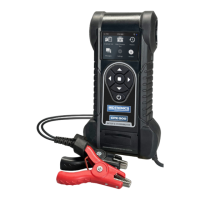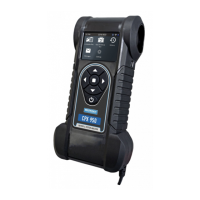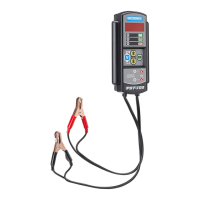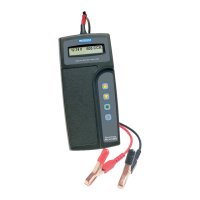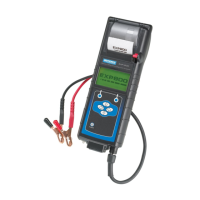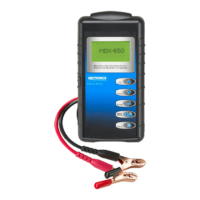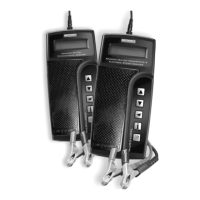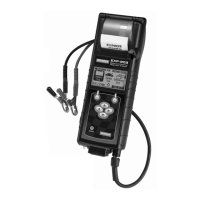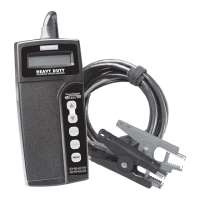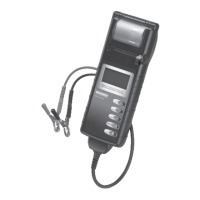Do you have a question about the Midtronics CPX-900PL and is the answer not in the manual?
Safety guidelines and warnings for handling batteries and using the analyzer.
Explanation of symbols used in the manual to indicate warnings and important information.
Policy regarding the collection, storage, and use of technical and personal data.
Identification and description of the analyzer's physical controls and connectivity ports.
Overview of the main screen interface and its navigation elements.
Detailed explanation of the icons presented in the main menu interface.
Description of the tester's startup process for the first time.
Instructions for setting up and configuring the tester's Wi-Fi connection.
Configuration settings for the Battery Information Management System (BMIS).
Input and management of shop-specific information for the tester.
Essential steps and checks to perform before starting a battery test.
Procedures for testing batteries that have been removed from a vehicle.
Procedures for testing batteries while they are installed in a vehicle.
Instructions for properly connecting the tester's clamps to battery terminals.
Customizing analyzer settings to suit user preferences.
Performing battery tests on batteries installed within a vehicle.
Step-by-step guide for conducting a battery test on an in-vehicle battery.
Using the on-screen keypad to manually input the vehicle identification number (VIN).
Configuring specific battery parameters before initiating a test.
Interpreting the results and status indicators of a completed battery test.
Performing a system test to evaluate the starter and charging system performance.
Procedures for testing batteries that are not connected to a vehicle.
Steps to conduct a battery test on a battery removed from a vehicle.
Configuring battery parameters for testing when the battery is out of the vehicle.
Reference to the battery test result screens and descriptions found in Chapter 2.
Accessing the tool usage history and vehicle test records.
Viewing the list of recorded tests, searchable by VIN or result.
Accessing alerts and notifications regarding tool software updates.
How to view unread critical messages displayed next to the Messages icon.
Setup and adjustment of tester display, time, language, and number formats.
Configuring the date and time format and setting the current date and time.
Setting default print options for test results, including shop info and SoH.
Configuring work order text display and enabling VIN entry for tests.
Enabling or disabling the automatic test function when a battery is connected.
Displaying technical information for internal tester software and hardware.
Configuring shop details and setting an administrative PIN for security.
Entering and managing shop-specific information used by the tester.
Configuring network connectivity and Wi-Fi settings for the analyzer.
Entering credentials for the Battery Information Management System.
Guidelines for cleaning, handling, and storing test cables to prevent damage.
Information about the internal printer's paper and availability of replacement rolls.
Step-by-step instructions for replacing the thermal printer paper roll.
Instructions for opening the battery compartment and replacing internal batteries.
Decision tables explaining the interpretation of alternator test results and actions.
Safety guidelines and warnings for handling batteries and using the analyzer.
Explanation of symbols used in the manual to indicate warnings and important information.
Policy regarding the collection, storage, and use of technical and personal data.
Identification and description of the analyzer's physical controls and connectivity ports.
Overview of the main screen interface and its navigation elements.
Detailed explanation of the icons presented in the main menu interface.
Description of the tester's startup process for the first time.
Instructions for setting up and configuring the tester's Wi-Fi connection.
Configuration settings for the Battery Information Management System (BMIS).
Input and management of shop-specific information for the tester.
Essential steps and checks to perform before starting a battery test.
Procedures for testing batteries that have been removed from a vehicle.
Procedures for testing batteries while they are installed in a vehicle.
Instructions for properly connecting the tester's clamps to battery terminals.
Customizing analyzer settings to suit user preferences.
Performing battery tests on batteries installed within a vehicle.
Step-by-step guide for conducting a battery test on an in-vehicle battery.
Using the on-screen keypad to manually input the vehicle identification number (VIN).
Configuring specific battery parameters before initiating a test.
Interpreting the results and status indicators of a completed battery test.
Performing a system test to evaluate the starter and charging system performance.
Procedures for testing batteries that are not connected to a vehicle.
Steps to conduct a battery test on a battery removed from a vehicle.
Configuring battery parameters for testing when the battery is out of the vehicle.
Reference to the battery test result screens and descriptions found in Chapter 2.
Accessing the tool usage history and vehicle test records.
Viewing the list of recorded tests, searchable by VIN or result.
Accessing alerts and notifications regarding tool software updates.
How to view unread critical messages displayed next to the Messages icon.
Setup and adjustment of tester display, time, language, and number formats.
Configuring the date and time format and setting the current date and time.
Setting default print options for test results, including shop info and SoH.
Configuring work order text display and enabling VIN entry for tests.
Enabling or disabling the automatic test function when a battery is connected.
Displaying technical information for internal tester software and hardware.
Configuring shop details and setting an administrative PIN for security.
Entering and managing shop-specific information used by the tester.
Configuring network connectivity and Wi-Fi settings for the analyzer.
Entering credentials for the Battery Information Management System.
Guidelines for cleaning, handling, and storing test cables to prevent damage.
Information about the internal printer's paper and availability of replacement rolls.
Step-by-step instructions for replacing the thermal printer paper roll.
Instructions for opening the battery compartment and replacing internal batteries.
Decision tables explaining the interpretation of alternator test results and actions.
| Display | LCD |
|---|---|
| Communication | USB |
| Operating Temperature | 32°F to 122°F (0°C to 50°C) |
| Current Range | 0 to 2000A |
| Housing Material | Plastic |
| Measurement Capabilities | Voltage, Current, Resistance, Conductance |
| Battery Types | AGM, Gel |
